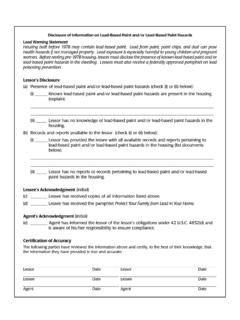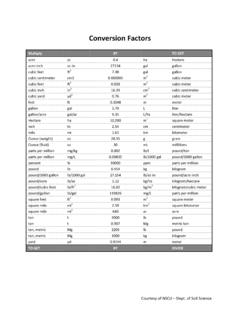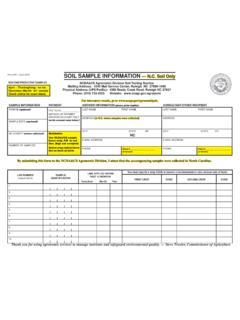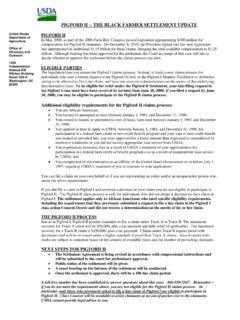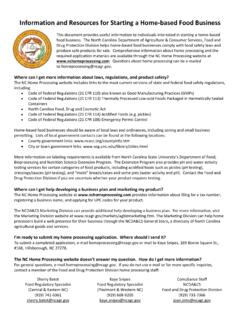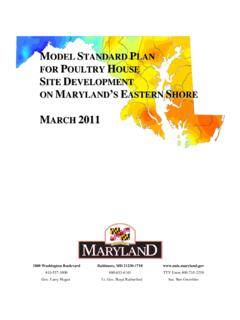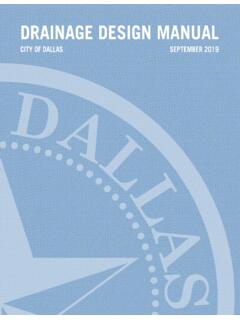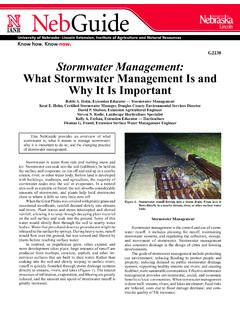Transcription of 8.0 Vegetated Swales
1 64 Vegetated Swales Overview of Practice Swales often serve to convey water around and away from businesses and residences. They are Vegetated , open channels, most often lined with grass . From a water quality perspective, they are preferable to pipes because they allow more soil and water contact, as well as more opportunity for infiltration. Filtration of sediment and debris can also occur within Swales , especially if the grass is kept relatively long. Figure shows grassed Swales in Durham and Wake Counties. Figure shows two Swales in the Raleigh-Durham area.
2 Both have turf reinforcement mats. The former is mowed while the latter contains a taller grass stand. Determining Site Constraints CCAP does not allow a total riprap lined channel unless recommended by a PE. They cost share on TRM if it s within the designer s JAA or recommended by a PE. The first step in designing a Vegetated swale is to determine the constraints of the site. Slope The swale must convey flow from an upland area to an area that is lower in elevation. Often, Swales will lead from a point in the watershed to an SCM or from an SCM to the existing drainage infrastructure.
3 This information can be used to determine the allowable slope of the swale . The swale should have a relatively constant slope between its inception and destination. If changes in slope are necessary, they should be gradual. Slope (S) = elevation change from start to end (ft) length of swale (ft) Top Width 65 The maximum width of the swale may be dictated by site constraints. Determine the maximum width before beginning calculations. Side Slopes It may be desirable at some sites to leave the side slopes of a swale mild enough that they can be mowed with a riding lawn mower.
4 If this is the case, a slope of 4:1 (H:V) or flatter is recommended, no steeper than 3:1 is recommended in most cases, and never more than 2:1. Triangular Swales may be used on small catchments less than 2 acres but is dependent upon the slope, the velocities may not allow it. Shape Both trapezoidal and triangular cross-sections are used for water quality Swales . The depth of flow within these channels is shallow during small storms which allows increased soil and grass contact with the stormwater, and therefore increased infiltration and filtration.
5 Triangular shaped Swales are more appropriate for small drainage areas, but trapezoidal Swales may also be used. Peak Flow Swales should be designed to convey the peak flow of the 10-year storm without overtopping, which is calculated using the Rational Method (section ). During extreme events ( 25 or 100-year storms), portions of the swale may be breached and should be repaired by the property owner as necessary. Depth and Velocity Calculations Swales should be able to carry their design flow without overtopping or eroding. If the velocity is too high for grass cover in a given swale design and the slope and cross-section cannot be adjusted, the swale can be reinforced with rip-rap or turf reinforcement matting, which can withstand a higher velocity.
6 There are several approaches to designing a swale . A site may have constraints which dictate the channel slope and cross-section, in which case the designer must simply ensure that the channel lining will be strong enough to handle the velocities produced. Conversely, there may be flexibility with respect to the channel cross-section, and the designer may choose to size it such that a simple grass lining, which reduces installation costs, will be sufficient to prevent erosion. Figure shows a diagram of a swale with a trapezoidal cross-section and illustrates some of the parameters discussed in this section.
7 The equations used in trapezoidal channel design are as follows: Equation 8-1: The Continuity Equation Q = VA Where: Q = flow rate (cfs) V = average velocity of the cross-section (ft/s) A = cross-sectional area of the flow (ft2) 66 And: A = bd + xd2 (refer to figure ) Equation 8-2: Manning s Equation V = * (1/n) * R2/3 * S1/2 Where: V = velocity (ft/s) n = Manning roughness for a chosen channel lining (Table ) R = hydraulic radius (ft) S = channel bed slope (ft/ft) The hydraulic radius (R) is equal to the cross-sectional area of flow (A) divided by the wetted perimeter (Wp) (see Figure ), or for trapezoidal channels: R = (bd + xd2) / (b + 2dx) *all dimensions in ft For convenience, the top width of the trapezoidal channel can be calculated as: swale Top Width = b + 2Dx *all dimensions in ft Figure Trapezoidal swale cross-section.
8 The correct cross-section must be determined by trial and error. A computer spreadsheet or other software ( , TR-55) would be helpful in this process and may be obtained from SWCD personnel in Raleigh. First, assume a channel geometry, and use the Continuity Equation (Equation 8-1) and Manning s Equation (Equation 8-2) to determine the average velocity of flow for the design storm. By using the maximum permissible velocity method, it can be determined whether the channel will erode. Table shows maximum permissible velocities for a variety of channel linings.
9 Manufactured products should have maximum permissible velocity specifications available. If the channel velocity exceeds the maximum permissible velocity for a given surface lining, erosion will occur. It is good practice to design conservatively. Multiply the calculated velocity by a safety factor of when comparing with the maximum permissible velocities in Table 67 Assume that grass will not be mowed regularly when selecting a Manning n. Leave at least feet of freeboard at the top of the swale during the 10-yr storm. The channel can be reinforced with turf reinforcement matting (Figure ) or riprap if velocities cannot be lowered sufficiently by enlarging the swale .
10 Table Manning s n values for various channels. Type of Channel Lining Design n grass Riprap Turf Reinforcement Matting Table Maximum permissible velocities for various channel linings. Type of Channel Lining Maximum Permissible Velocity (ft/s) grass 4 Riprap Turf Reinforcement Matting * Please check the manufacturer s specifications to determine the maximum permissible velocities for Turf Reinforced Matting as these vary from product to product. The table above is a general listing for the maximum permissible velocities for TRMs.



